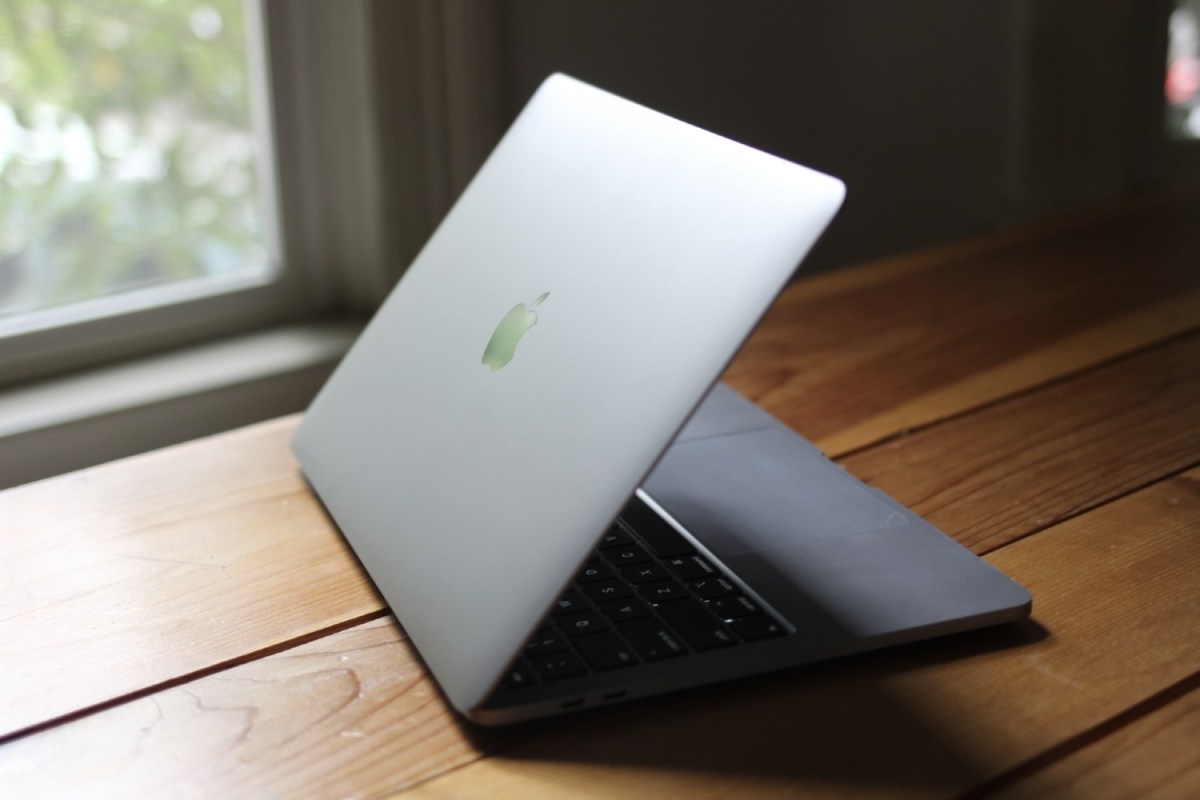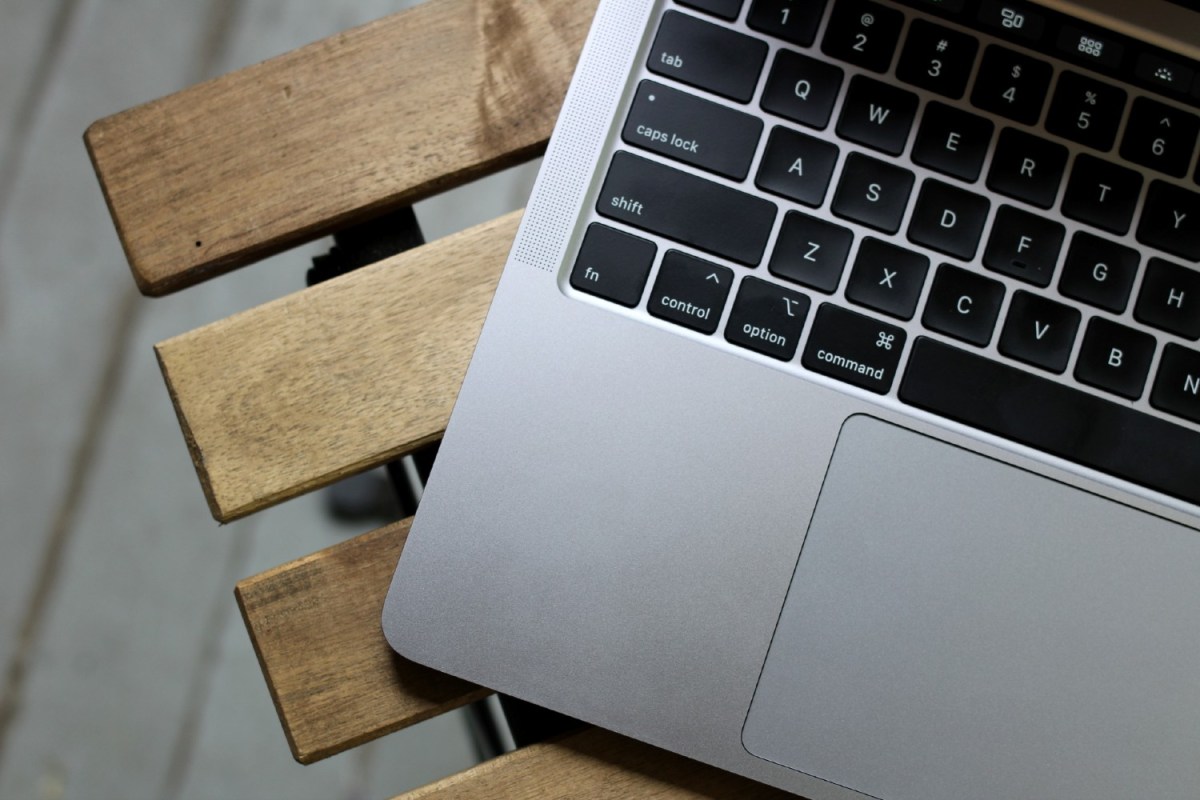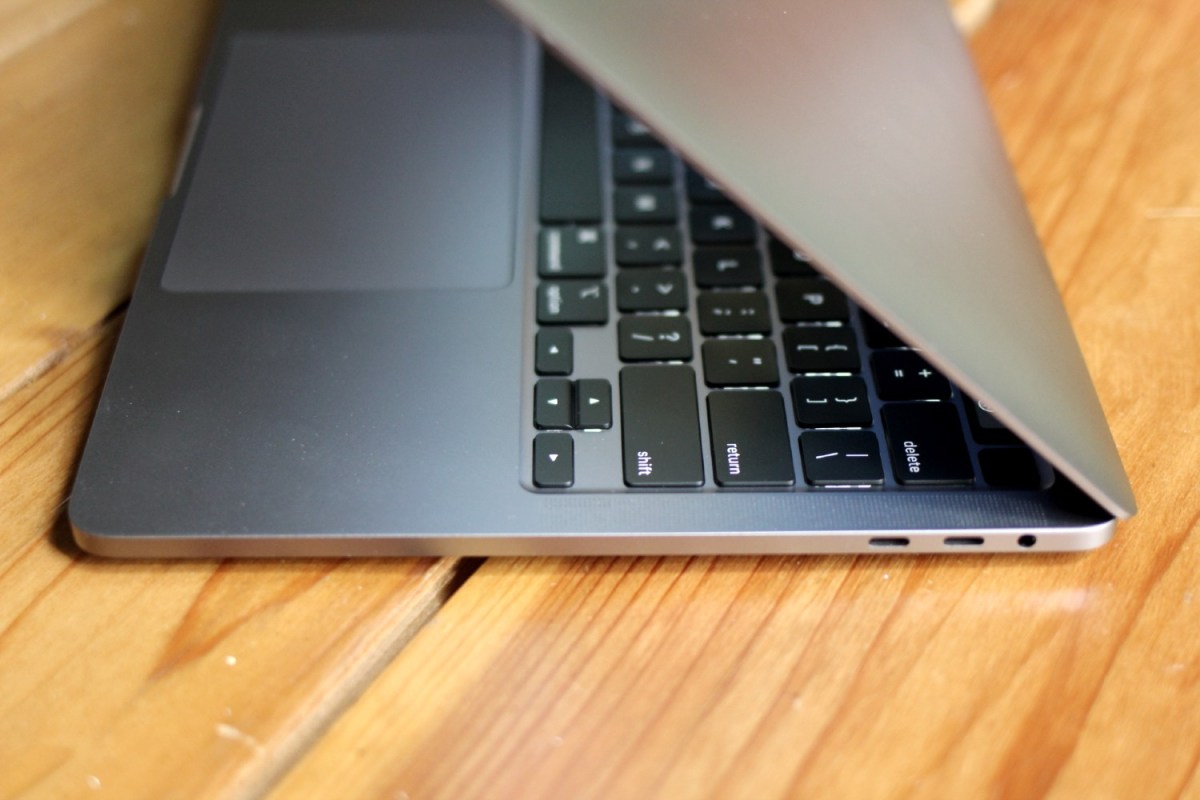- Industry-leading display
- Thin and light design
- Excellent new keyboard
- Hard-as-rock build quality
- Confusing processor choices
- Average battery life
Editor’s note: Read our full review of the newer M1 MacBook Pro 13-inch.
The MacBook Pro 13 plays a crucial role in Apple’s lineup. It’s not a true “pro” laptop — that’s the MacBook Pro 16. It’s for the hobbyist. The amateur. The aspiring pro.
Let’s face it. The number of people who actually need professional-level performance is relatively small, while hobbyist graphic designers, YouTubers, music producers, and photographers are a dime a dozen. It’s a demographic that includes some of Apple’s biggest fans, and the MacBook Pro 13 shows why.
Price and configurations

The way Apple prices the MacBook Pro reflects that aspiring hobbyist nature of this laptop. It’s expensive. Even more expensive than before. The base model starts at $1,299, which sounds like a fair price.
That’s until you realize Apple is selling old hardware in a new laptop. Aside from the keyboard, this “new” MacBook Pro is identical to the one it was selling a year ago.
This isn’t what other laptops manufacturers do. You can get the latest 10th-gen processors in the Dell XPS 13, Surface Laptop 3, or HP Spectre x360, in configurations starting at $1,200 or less. This isn’t Apple’s standard practice either. The company tends to update its Macs at a slower rate than other companies, but when a new model comes out, it often has the latest silicon.
And I can’t imagine Apple releasing a new flagship iPhone or iPad that uses last year’s processor. It instead releases old designs with new processors, like the iPhone SE.
That makes configuring a MacBook Pro a complete mess. Good luck choosing between the 8th-gen Core i7 and the 10th-gen Core i5. Strangely, it’s the 8th-gen that costs $100 more when similarly configured. Spec for spec, Apple is upcharging you $200 for the modest jump from 8th-gen to 10th-gen Intel processors. It also charges more for faster memory, perhaps in attempts to sweeten the deal on high-end models.
There’s one glimmer of light in the new configurations. Storage. The base model now comes with a 256GB SSD rather than 128GB, and the $1,799 model has 512GB. That’s already the standard for many laptops, and I’m happy to see Apple follow suit.
Performance

One thing could change my sour impression of the MacBook Pro 13’s hardware options. Performance. Maybe Apple cooked up something special. It’s possible, as the Intel 10th-gen Core chips in more expensive configurations are specific to the MacBook Pro.
My review unit had Intel’s Core i5-1038NG7, a 25-watt processor with four cores and eight threads. It’s similar to the Intel Core i5-1035G7, a 15-watt processor that shows up in many 13-inch laptops including the Dell XPS 13, HP Spectre x360, and the Microsoft Surface Laptop 3.
Those 10 extra watts do add some performance, but as I learned, it’s a modest uptick. The MacBook Pro 13 beats most other 13-inch laptops in Cinebench R20 and Geekbench 5 — especially laptops that don’t push the CPU hard, like the Spectre x360 or the Razer Blade Stealth. The Dell XPS 13 is a notable exception. It uses thermal tricks to push the processor more than others, and despite it having a lower-wattage chip, it beats the MacBook Pro 13 in most benchmarks.
The MacBook Pro 13-inch’s performance squeaks by for a hobbyist.
But in real-life applications, the MacBook Pro 13 punches back. I encoded a 4K video in Handbrake to H.265 in just over 3 minutes, which is 10 seconds faster than the Dell XPS 13. This is the best video-encoding score I’ve yet seen from a 13-inch laptop, though not by a lot. Again, this is with the $1,799 model, featuring the 10th-gen Core i5, 16GB of RAM, and 512GB of storage.
That doesn’t mean the MacBook Pro is a content-creation machine. To export a 4K 2-minute clip to ProRes 422 took a painfully long 16 minutes. The 16-inch MacBook Pro can do this in about half the time, thanks to more processor cores and a discrete graphics card. The problem is that laptop starts at $2,499, more than double the price of the entry-level MacBook Pro. The $1,799 sits in between the two in terms of price, but not in terms of performance.
The MacBook Pro 13-inch will squeak by for a hobbyist, though. If you do music production in Logic, photography in Lightroom, or YouTube videos in Final Cut, the 13-inch MacBook Pro won’t get in your way too much, as long as you aren’t pushing the machine with high resolutions or codecs. If you aren’t making a living in these applications, paying $2,499 or more for a laptop isn’t feasible. In that case, dealing with some hiccups or longer render times is your only choice.
Of course, the MacBook Pro 13 can easily handle dozens of Chrome tabs, Slack, Spotify, and streaming video. If that’s all you need to do, the more affordable MacBook Air would probably be a better choice.
Design

The MacBook Pro 13’s four-year-old design is now on its fourth iteration. That’s not unheard of for Apple, and it’s not necessarily a bad thing. There are areas where the MacBook Pro still leads. You can open it with one finger, yet the screen isn’t wobbly. The speakers are unparallel, blowing every other 13-inch laptop out of the water. They have more bass and a rich stereo spread that pulls out details in songs like you’ve never heard in a laptop.
But a few wrinkles show, including the screen bezels. With the MacBook Pro 16, Apple trimmed down its bezels in favor of a larger screen. That’s less wasted space and more screen real estate. However, the MacBook Pro 13 is stuck with chubby bezels. Rumor has it a 14-inch MacBook Pro is in the works that takes a similar approach, but it’s not likely to launch in 2020.
It has a super-sleek profile that dozens of laptops have tried but failed to replicate.
You can’t fault Apple for its unibody aluminum chassis, however. Many have attempted to duplicate Apple’s machined aluminum body. The Space Gray colorway still looks fresh and sophisticated, especially sitting next to light gray Surface devices, or one of the myriad of nondescript black laptops. I do wish the glorious gold finish from the MacBook Air was an option, though.
I can’t complain about the size either. The MacBook Pro isn’t the thinnest or smallest 13-inch laptop in the world, but it still feels slim. Without setting it beside the 0.58-inch XPS 13, you wouldn’t be crazy to assume the 0.61-inch MacBook Pro was thinner. The unibody structure gives it a super-sleek profile that dozens of laptops have failed to replicate.
The MacBook Pro 13’s Thunderbolt 3 ports were a trendsetter when first released, but today they’re fairly standard. The $1,799 model comes with four Thunderbolt 3 ports, while the $1,299 model has just two. On the cheaper model, Apple places both ports on the left side, which is a bit inconvenient for charging purposes.
Display quality

The MacBook Pro line is a leader in display quality, though that picture has slowly changed over the past couple of years. The MacBook Pro 13’s 2,560 x 1,600 screen is crisp, especially for a 13.3-inch screen. If you’re used to a 1080p screen, you’ll notice the difference in sharpness right away.
But laptops like the XPS 13 or Spectre x360 now offer 4K screen options that are even more pixel dense, while still being every bit as bright, vibrant, and color-accurate. Configured the same, the 4K Spectre x360 is $500 cheaper, while the XPS 13 is $140 cheaper. HP even offers an OLED option that features unbelievable black levels that conventional LED can’t match. These days, those screens are even better-equipped for precise photo editing than the MacBook Pro.
Rumor has it that Apple is investing in the next evolution of its display technology, mini-LED, but it looks like we’ll have to keep waiting for it.
The Magic Keyboard and Touch Bar

Beyond the internal updates, the Magic Keyboard stands out as the MacBook Pro’s most important feature. Is that a sad state of affairs? Maybe, but you can count on one hand the amount of times Apple has reversed course this sharply. It’s a big deal.
I’m not convinced this will be Apple’s last attempt to reinvent the keyboard, but for now, it’s retreated to a conventional design. Each key has a scissor switch, a rubber dome, and a full millimeter of travel.
It’s not a return to the 2015 MacBook Pro, though. The keycaps are sturdier and less wobbly, and the keypresses have a sharper click. It’s fantastic — a quiet, comfortable keyboard I felt instantly at home with. The inverted “T” shape of the arrow keys is back, as is the Esc key. All of these came to the MacBook Air and MacBook Pro 16-inch first, but I’m happy nonetheless.
The Magic Keyboard is a quiet, comfortable keyboard I felt instantly at home with.
The trackpad hasn’t changed, nor should it. A lot of engineering magic happened in the initial design in 2016, and it still stands as the best trackpad on a laptop.
The Touch Bar sits in place of the function row, and it hasn’t grown on me in the past few years as I’d hoped it would. It still freezes occasionally, leaving me unable to turn down my music or screen brightness. It’s rarely useful, and I often forget it’s there. I was ecstatic when Apple introduced it in 2016. What an exciting innovation! But since then, Apple has done very little to develop it into a feature that feels necessary.
Touch ID still sits on the top right of the Touch Bar, offering quick sign-ins and Apply Pay purchases. I miss facial authentication in the vein of Face ID or Windows Hello. Mac remains the only major OS to not implement some kind of facial recognition.
Battery life

The current MacBook Pro has never boasted stellar battery life. You can expect around 6 to 7 hours on a single charge, depending on how hard you push it. I averaged around 6.5 hours on my typical workflow of web apps.
When compared to 1080p laptops like the XPS 13 or Spectre x360, the MacBook Pro gets crushed. The XPS 13 should net you an extra 4 hours of battery life, which makes the MacBook Pro look fairly weak by comparison.
Once you jump up to 4K screen, though, the score is a bit more even. I haven’t reviewed the latest 4K model of the XPS 13, but in previous generations, it lasts 45 minutes less than the MacBook Pro in the same web-browsing battery test.
Our take
The MacBook Pro 13-inch is a mixed update. It fixes the troubled keyboard, but Apple’s decision to stick with older hardware for entry-level configurations is a big problem. The design is aging in some respects, but remains sleek and compares well to most alternates. The MacBook Pro offers you the feeling that you can do anything, but you’ll only have the right tools if you opt for the most expensive configurations — which are very expensive indeed.
Are there any alternatives?
The best 13-inch laptop is the Dell XPS 13. It beats the MacBook Pro in most areas, and looks just as good doing it. Even the 4K model undercuts the MacBook Pro in price.
If you’re set on a Mac, your other two options are the MacBook Air and the 16-inch MacBook Pro. Both offer better value than the MacBook Pro 13. Configured with the quad-core Core i5, the MacBook Air is ideal for students and anyone who runs simpler applications. The MacBook Pro 16 is the best choice for serious creative professionals.
How long will it last?
The MacBook Pro 13 should last you at least five years or more. Apple is known for making extremely dependable products. If you buy the entry-level $1,299 model, though, that processor is a full year behind other new laptops you buy in 2020.
Should you buy it?
Yes. It offers just enough extra performance to be a solid option for aspiring creative professionals.
So, are you sold out? In case you have a positive answer, then you can leverage many MacBook deals that are offered throughout the year.
Editors' Recommendations
- Best Apple deals: Save on AirPods, Apple Watch, iPad, MacBook
- The 5 best MacBooks for video editing in 2024
- The best MacBook to buy in 2024
- Best laptop deals: Save on the Dell XPS 14, MacBook Pro 16 and more
- Best MacBook deals: Get an Air for $605 and save on M3 MacBook Pro



